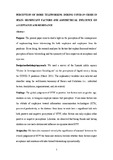Mostrar el registro sencillo del ítem
Perception of home teleworking during COVID-19 crisis in Spain: significant factors and assymetrical influence on acceptance and resistance
| dc.creator | Andrés-Sánchez, Jorge de | es_ES |
| dc.creator | Belzunegui Eraso, Ángel | es_ES |
| dc.creator | Erro Garcés, Amaya | es_ES |
| dc.date.accessioned | 2023-09-14T06:48:40Z | |
| dc.date.available | 2023-09-14T06:48:40Z | |
| dc.date.issued | 2023 | |
| dc.identifier.citation | De Andres-Sanchez, J., Belzunegui-Eraso, A., Erro-Garcés, A. (2023) Perception of home teleworking during COVID-19 crisis in Spain: significant factors and assymetrical influence on acceptance and resistance. International Journal of Manpower, 1-21. https://doi.org/10.1108/IJM-10-2022-0505. | en |
| dc.identifier.issn | 0143-7720 | |
| dc.identifier.uri | https://hdl.handle.net/2454/46320 | |
| dc.description.abstract | Purpose.This paper aims to shed light on the perception of the consequences of implementing home teleworking (TW) for employers and employees amid the pandemic. By doing so, the research analyzes the factors that explain employers’ and employees’ perceptions of home TW and the symmetry of their impact on its acceptance and rejection. Design/methodology/approach. The analysis is done over the survey “Trends in the digital society during SARS-COV-2 crisis in Spain” by the Spanish “Centro de Investigaciones Sociol ogicas.” The explanatory variables were selected and classified using the well-known taxonomy of Baruch and Nicholson (i.e. individual factors, family/home, organizational and job-related). Findings. The global judgment of HTW is positive, but factors such as gender, age, children in care or being an employer nuance that perception. While some factors, such as the attitude of employees toward information communication technologies (ICTs), perceived productivity or the distance from home to work, have a significant link with both positive and negative perceptions of HTW, other factors can only explain either positive or negative perceptions. Likewise, the authors observed that being female and having children on care had a detrimental influence on opinions about HTW. Practical implications – A clearer regulation of TW is needed to prevent imbalances in rights and obligations between companies and employees. The authors also highlight the potentially favorable effects of telecommuting on mitigating depopulation in rural areas. Originality/value. The authors have also measured not only the significance of assessed factors on the overall judgment of HTW for firms and workers but also whether these factors impact acceptance and resistance attitudes toward TW symmetrically. | en |
| dc.description.sponsorship | This work was funded by “INAP, Instituto Nacional de Administración Pública”, which nowadays belongs to the Spanish “Ministerio de Hacienda y Función Pública”.Project: Teleworking in public administrations. Present and key issues for the future (T20165S). | en |
| dc.format.mimetype | application/pdf | en |
| dc.language.iso | eng | en |
| dc.publisher | Emerald | en |
| dc.relation.ispartof | International Journal of Manpower, (2023), 1-21 | en |
| dc.rights | © 2023, Jorge de Andres-Sanchez, Angel Belzunegui-Eraso and Amaya Erro-Garcés. This article is published under the Creative Commons Attribution (CC BY 4.0) licence. | en |
| dc.rights.uri | http://creativecommons.org/licenses/by/4.0/ | |
| dc.subject | Teleworking | en |
| dc.subject | Home teleworking | en |
| dc.subject | COVID-19 pandemic | en |
| dc.subject | Asymmetrical influence | en |
| dc.subject | Spanish labor market | en |
| dc.title | Perception of home teleworking during COVID-19 crisis in Spain: significant factors and assymetrical influence on acceptance and resistance | en |
| dc.type | Artículo / Artikulua | es |
| dc.type | info:eu-repo/semantics/article | en |
| dc.date.updated | 2023-09-14T06:29:59Z | |
| dc.contributor.department | Gestión de Empresas | es_ES |
| dc.contributor.department | Enpresen Kudeaketa | eu |
| dc.rights.accessRights | Acceso abierto / Sarbide irekia | es |
| dc.rights.accessRights | info:eu-repo/semantics/openAccess | en |
| dc.identifier.doi | 10.1108/IJM-10-2022-0505 (Erróneo) | |
| dc.relation.publisherversion | https://doi.org/10.1108/IJM-10-2022-0505 | |
| dc.type.version | Versión publicada / Argitaratu den bertsioa | es |
| dc.type.version | info:eu-repo/semantics/publishedVersion | en |



